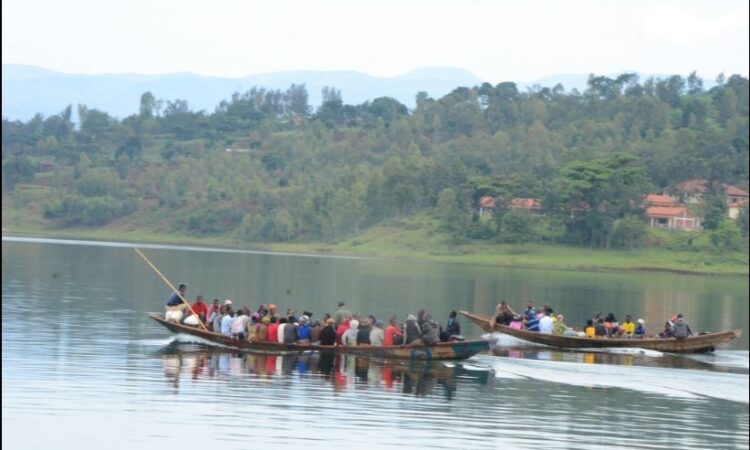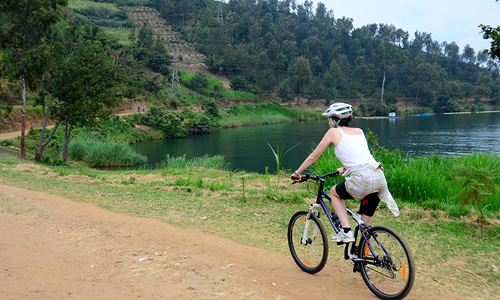Nkombo Island is Of the roughly 40 islands in southern Rwanda’s expansive Lake Kivu, Nkombo is the largest. The name “Nkombo,” in the local Kinyarwanda tongue, is an expression for an uncultivated bird’s nest, underscoring the island’s ecological pre-eminence over all other Lake Kivu islands. As with other Kivu islands, Nkombo’s myriad inhabitants are dependent on the lake for their livelihood and survival. Lakeside peoples invariably depend heavily on the biological productivity of their freshwater environments, and this is clearly evident in their economies, where fish form staple parts of their diets, cork from papyrus reeds is harvested for wine bottle-stoppers and other commercial products, and floating island vegetation is used for livestock feed. However, such dependence on a shared and limited natural resource is susceptible to negotiations leading to conflict among users.

Nkombo Island merits special attention because it is the largest of the Lake Kivu islands, and the need to maximize the sustainable benefits generated from the relatively limited terrestrial and aquatic resources available on the island is particularly urgent. Livelihoods among islanders do, in fact, largely depend on these resources. Africa’s population growth rates are among the world’s highest, and the Rwandan population is no exception, more than doubling in numbers since 1960. Rural incomes remain dependent on agriculture and are greatly strained by the need to subdivide land among family members as generations succeed one another. To compound matters, the limited land available for grazing animals severely restricts the carrying capacity necessary for cows and goats, not to mention forces ever-larger herds onto ever-diminishing areas of pasture.
Nkombo is located on Lake Kivu in Rwanda, in the southern part of the country. It lies in the Karongi district of the Western Province, while the island forms the commune that stretches to Bwishyura in the west. The farthest part of Nkombo Island is about 10.5 kilometers from the shore. The Nkombo archipelago is essentially made up of four islands: Nkombo, Amahoro, Iwawa, and Gatovu on the south, with one other outcropping on the north of the peninsula. It also encompasses Chibitoke, Caretaker, and Mparwa inlets to the north. The total surface area of the islands is about 16 km2, of which around 60% is used for living and agriculture, 11% for conservation, and fewer than 5% for economic activities like transportation, mining, and tourism. Nkombo is distinct because of its lush green slopes, many boulders from the smaller boulders to large ones making up some of the island and landscaping the few private islands present.
Four of the islands are adjacent to the shores of Bwishyura, and another is closer to the north shore. The largest island is Nkombo, followed by Ravuvu, Iwawa, and Gatovu. These islands are spread in a 10 km long line, southwest of Bwishyura. Nkombo is the farthest of these islands, located away from the coast on the south end of the line. They are located at the western shore and are part of the Kivu Archipelago. This group, which fills the western shores of the Rwanda Kivu Lake, is divided into two branches: the Nyamasheke branch, east of Bwishyura, and the Karongi branch, west of Bwishyura. Finally, the fifth group is placed in the central area of the southern part of the Rwanda Kivu Lake.
This island is significantly important to Rwandans due to its instant accessibility as a place of prayer and receiving blessings at the time of disaster or seeking blessings. The recorded historical fact is that everybody, a king-elect or someone who was able to be enthroned as a King of Rwanda, had to arrive at this island “Nkombo” with a specific kind of grass when selected as a candidate to wash his/her body by applying some kinds of blessings like blessing by throat, etc. The island played such an important role which affected public belief, thus it is known as the “Island of Truthfulness”.
The island has underneath a source of the surrounding area according to the social relationship fraud to affect the water or source. As the island is the “centre of truthfulness and clearness source,” this had a deep historical and cultural meaning for the people. Public rules believed it to be the centre of sediments and sorrows to relieve, as it contains mineral materials protecting people from diseases. People relieve themselves by drinking the water containing the minerals of salts. The affected people respond to the rules inside the water as “the source which is flowing here from the underground of Nkombo island is strictly forbidden to the girl on menses to enter behind the line along the deepest of the source”.
Here are a few activities tourist can do while at Nkombo Island:
Coffee and tea tours
Coffee along with sorghum are major cash crops and appear on the national court of arms. Almost every household in rural areas grows coffee and there are beautiful tea plantations near Nyungwe forest national park including Gisakura tea estate. You can either visit a farm or a farmer’s cooperative group to learn more about the coffee experience. Right from how it is grown to how it is harvested and finally put into a cup for consumption. By doing a coffee tour in Rwanda, you will be supporting the small-scale farmers.
Lowland gorilla trekking
Nkombo island is also a perfect island retreat for those intending to visit Kahuzi Beiga National Park, a UNESCO world heritage site famous for harbouring lowland gorillas. Cyangugu town is situated on the banks of River Rusizi where Rwanda borders with the DR Congo. There’s a bridge that links the two countries and just across the border is the town of Bukavu, capital city of South Kivu Province. Since Virunga National Park isn’t open yet, the only option available for the DR Congo gorilla tour is to visit Kahuzi Biega for lowland gorilla trekking. This is to do from Cyangugu town rather than from Goma city in the North Kivu Province.
Biking the Congo Nile Trail
Cyangugu town is the 8th and end stage of the Congo-Nile trail, making for perfect biking excursions from Nkombo island. You can rent a bike to explore the island or the lakeshore dirt tracks with a local guide. The start point of the Congo-Nile trail is in Gisenyi resort town on the northern end of Lake Kivu.

Chimpanzee trekking
Nyungwe forest national park is 55 km (1-hour drive) east of Cyangugu town, making for a perfect island retreat after chimpanzee trekking. In addition, the park offers a canopy walk and over 10 nature trails for keen birders and hikers to explore the rich biodiversity including over 1,000 plants, 350 birds of which 16 are Albertine Rift Endemics, and 13 primate species including chimpanzees, Hamlyn’s monkeys, red colobus monkeys, black and white colobus monkeys, olive baboons, and blue monkeys. Nyungwe is 220 km (5-hour) southwest of Kigali capital city and can also be reached by air through Kamembe airport.


